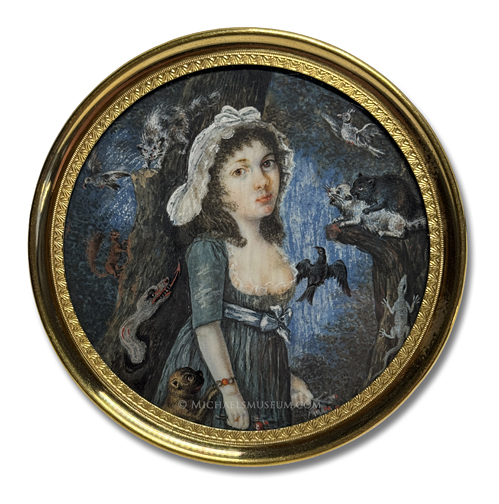French: Artist Unknown


Allegorical Miniature Depicting a Young Lady
in a Dark Forest Surrounded by Various Animals Symbolically
Representing the 'Tug of War' between Good and Evil
Believed to be of French origins
circa 1790-1795
Artist unknown
2 3/8 inches diameter (sight)
watercolor on ivory; housed under glass in a gilt metal surround
that was originally set within an ebonized wood frame
About the Portrait: The symbolism of this miniature is both unique and complex. Weighing the input of several fellow collectors and experts in miniature portraiture, we are of the belief that it is allegorical in nature and is meant to convey the dangers that confront a young lady of her time.
Depicted is a young lady in a dark forest, standing beside a decaying tree and surrounded by various animals that are believed to symbolically represent the "tug of war" between good and evil.
At the young lady's side is her beloved pet pug, appearing to plead with her to pick him up and return home. Fluttering around her are three birds, one white, one black and one gray, likely representing the black, white and shades of gray involved with truth or lack thereof. Interestingly, an angry-looking cat appears to be ready to pounce on one of the birds, while a squirrel looks on curiously. Symbolically, squirrels often represent playfulness or resourcefulness and planning (stemming from their gathering and storing of nuts for winter), but they are also known to represent gossip, impulsiveness and hoarding. Opposite them, on a decaying branch, two more cats can be seen copulating. The rough, carnal scene is likely intended to be a warning to the young lady that romance or love is not always what it seems to be.
Perhaps not surprisingly, the young lady holds wild roses in each hand. In many cultures, roses are believed to have protective properties, especially with regards to protecting virginity. Surely also meant to serve as a protective talisman is the bracelet the young lady wears with a a coral cabochon. Coral jewelry was often worn during the period by children and young adults, as it was believed to protect the wearer from negative energy and evil spirits.
Lastly, there are the reptiles... A chameleon appears to the right, likely a warning to beware of duplicity and deceit, and a snake/serpent appears to the left, likely a warning to beware of the whispers of temptation that he seems intent to speak into her ear.
Of course, the real question is, why was this miniature portrait created in the first place? Was it intended as a message for a particular young lady to reflect on as she entered adulthood or perhaps marriage -- perhaps created as a tool for discernment, encouraging the young lady to use her intuition to discern good from evil as she grows into womanhood? Was it intended as a tool of social commentary, to speak to the sad reality of how daughters were often considered negotiable commodities in the young lady's time? Or was it simply intended to reflect on the reality of the world around all of us -- full of temptation and evil, but also full of love and devotion when one looks in the right place?
|